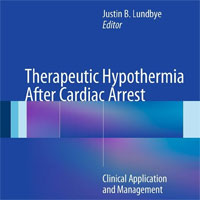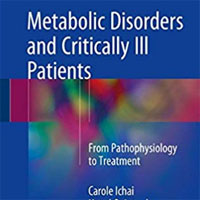Tag: hypothermia
Reducing Mortality in Critically Ill Patients
This book describes the techniques, strategies, and drugs that have been demonstrated by multicenter randomized trials to influence survival in critically ill patients, defined as those who have acute failure of at least... read more

Vasoactive Agents in Cardiogenic Shock Related to AMI and ADHF
Cardiogenic shock (CS) is a heterogeneous condition associated with exceptionally high mortality rates, despite significant advances in the field of cardiology. The primary causes of CS are myocardial infarction-related CS... read more
Therapeutic Hypothermia After Cardiac Arrest
Therapeutic hypothermia has emerged as a very important treatment option for patients with cardiac arrest as it provides significant protection from developing neurologic injury once the patient has been successfully resuscitated.... read more

Metabolic Disorders and Critically Ill Patients: From Pathophysiology to Treatment
Cellular metabolic abnormalities are responsible for systems and organ failures, so the modern approach of organ dysfunctions now includes prevention or treatment of such disorders. This book is a comprehensive tool, allowing... read more

Hypothermic Cardiac Arrest: Prognostic Factors for Successful Resuscitation Before Rewarming
Patients with core body temperature ... read more
Ultrafast Cooling With Total Liquid Ventilation Mitigates Early Inflammatory Response
Ultrafast cooling with TLV mitigates neuroinflammation and attenuates acute brain lesions in the early phase following resuscitation in large animals subjected to cardiac arrest (CA). Brain injury is one of the most serious... read more
EEG Patterns for Predicting Poor Outcome After Cardiac Arrest
The specificity of the ERC-ESICM-recommended EEG patterns for predicting poor outcome after cardiac arrest exceeds 90% but is lower than in previous studies, suggesting that large-scale implementation may reduce their accuracy.... read more
ECPR for Hypothermic Refractory Cardiac Arrests in Temperate Climates
Accidental hypothermia designates an unintentional drop in body temperature below 35 °C. There is a major risk of ventricular fibrillation below 28 °C and cardiac arrest is almost inevitable below 24 °C. In such cases,... read more
Postoperative Pulmonary Complications in the ENIGMA II Trial
Respiratory complications remain among the most common and serious adverse outcomes of major surgery. In the Australian and New Zealand Audit of Surgical Mortality, postoperative pneumonia accounted for 44% of infective... read more
The 1,3,5 Approach to Pediatric Cardiac Arrest
While pediatric cardiac arrests are thankfully rare, their shock waves can seem incalculable. Several studies have outlined the mental health toll that these events can have on everyone involved. There is an appreciable... read more
ERC-ESICM Guidelines on Temperature Control After Cardiac Arrest in Adults
The aim of these guidelines is to provide evidence‑based guidance for temperature control in adults who are comatose after resuscitation from either in-hospital or out-of-hospital cardiac arrest, regardless of the underlying... read more
Hypothermia and Health-related Quality of Life Among Pediatric Cardiac Arrest Survivors
Out-of-hospital or in-hospital cardiac arrest treated with therapeutic hypothermia was associated with higher health-related quality of life scores despite having association with higher lactate and lower pH after resuscitation.... read more
Targeted Temperature Management in Adult Cardiac Arrest
Among adult patients with cardiac arrest, the use of targeted temperature management at 32–34 °C, when compared to normothermia, did not result in improved outcomes in this meta-analysis. There was no effect of initiating... read more
Hypothermia vs Normothermia for Out-of-Hospital Cardiac Arrest
Hypothermia was first introduced in 2002 by two studies, Bernard et al and The Hypothermia After Cardiac Arrest (HACA) trial. The latter, although a small trial, showed improved neurologic outcomes at six months when patients... read more
Effect of Moderate vs Mild Therapeutic Hypothermia on Mortality and Neurologic Outcomes in Comatose Survivors of Out-of-Hospital Cardiac Arrest
In comatose survivors of out-of-hospital cardiac arrest, a target temperature of 31 °C did not significantly reduce the rate of death or poor neurologic outcome at 180 days compared with a target temperature of 34 °C. However,... read more
Should We Prolong the Observation Period for Neurological Recovery After Cardiac Arrest?
Up to 9.6% of cardiac arrest patients with favorable outcomes recover consciousness after the recommended 7 days of observation, indicating the observation time of 7 days seems justified but longer duration may be needed.... read more
Low Technology, Mild Controlled Hypothermia for Necrotizing Enterocolitis Treatment
Low technology, mild controlled hypothermia was feasible, not related to adverse effects, and effective treatment for NEC Modified Bell's Stage II/III. It avoided surgery, bowel perforation, and extensive intestinal resection;... read more
Outcome Related to Level of Targeted Temperature Management in Postcardiac Arrest Syndrome of Low, Moderate, and High Severities
Targeted temperature management at 33–34°C was associated with a significantly higher rate of a good neurologic outcome in the moderate-severity postcardiac arrest syndrome group, but not in the low- or high-severity group. A... read more
Critical Care Management of Infectious Meningitis and Encephalitis
Central nervous system (CNS) infections represent 2.9% of the infections encountered in the intensive care unit (ICU). Among them, infectious meningitis and encephalitis, regardless of their community or healthcare-associated... read more
Consequences of Cardiopulmonary Bypass: What the Intensivist Needs to Know
Cardiopulmonary bypass (CPB) is common for most cardiac surgeries. CPB drains blood from the heart and returns it to the proximal systemic circulation allowing perfusion during the operative period. It was pioneered in 1951... read more
Hypothermia Plus Melatonin in Asphyctic Newborns
The early addition of IV melatonin to asphyctic neonates is feasible and may improve long-term neurodevelopment. To our knowledge, this is the first clinical trial to analyze the administration of IV melatonin as an adjuvant... read more
Give that Febrile Patient a Blanket!
The practice of not allowing patients with a fever to have a blanket is predicated on the intriguing and complex scientific relationship between body temperature and medical outcomes. We know that an elevated temperature... read more








